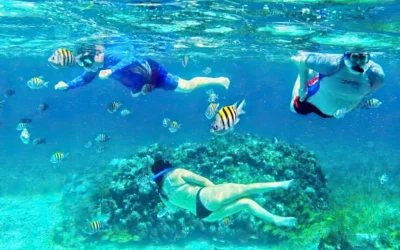- Avoid cotton: choose moisture-wicking fabrics like polyester or wool to prevent chilling, chafing, and clamminess.
- Layer up: wear breathable base layers, add long sleeves or fleece for warmth, and adjust as conditions change.
- Choose appropriate bottoms: hiking pants or athletic leggings for protection; shorts only for easy, hot day hikes.
- Bring outerwear: always carry a lightweight rain jacket; pack an insulated jacket or vest for cooler or late hikes.
- Prioritize socks and shoes: moisture-wicking wool socks and broken-in supportive shoes or boots ensure comfort and prevent blisters.
With all the gear available these days, it can be hard to figure out what to wear hiking.
But, have no fear. As an avid hiker myself, I've hiked around the block a few times. I've made the clothing mistakes while out and about so that you don't have to. More often than not, you already have many of the best items you'd want to wear for a hike. So, before you fret about what to wear hiking, look over our list. I'm guessing you'll only want to add one or two more things before you hit the trail.
The distance, terrain, weather, and your experience levels will all factor into your decision of what to wear hiking. You'll adjust your outfit depending on all of these things, and probably if you need to snap the perfect picture at the summit. So, make sure you have researched and gathered the hiking gear essentials in addition to this list of what to wear hiking. Let's dive into the best layers, material, and the items that will make the most of a difference while on your hike.
First Things First: Material
Before we dive into any specific article of clothing, let's address what every item you have on should be made of: not cotton. Cotton soaks up moisture, such as rain and sweat, and holds on to it. This causes chafing and will plummet your body temperature the second you stop moving or there is a little wind. It can also get quite clammy feeling which is definitely not enjoyable. Instead, choose moisture wicking fabrics or one made of other natural fibers. Polyester will be a common material for hiking gear, while wool is a natural and popular alternative.
This being said, I don't want anything to stop you from going out on a simple day hike. If you have a route you are confident in finishing well and safely, then by all means throw on a T-shirt and leggings and go hiking! But, when you start branching out into longer hikes or in areas of more extreme weather, it is incredibly important to be dressed for the occasion. If you are hiking alone, it is especially important to take care of yourself physically. By choosing what to wear hiking, you can prevent heat exhaustion, hypothermia, blisters, and simple discomfort. So, let's jump into our favorite hiking gear!
Hiking Shirts
Layers, layers, and more layers. This is one of the essential rules when it comes to what to wear hiking. Personally, I enjoy a moisture wicking tank top for sunny days on the trail. If you go this route, make sure to apply sunscreen before hand. It's also important to have comfortable straps on your backpack if you don't have the fabric layer covering your shoulders. So, tank tops are not for everyone, but if you like the extra freedom and sun on your skin, it is a great first layer.
If you prefer a little more coverage, check out a relaxed fit V-neck shirt. Often found in the running section online or in stores, any of these will do. These provide a little more protection from the elements while still allowing you to feel the breeze. This next option has gained quite a bit in popularity of the years as a great option of what to wear hiking. Long sleeve button up shirts, like this Colombia Bahama shirt is a phenomenal option. Providing sun protection with a light, airy, vented fabric allows you to go straight out to dinner after a hike without thinking twice about what you're wearing. The large pockets let you pair this well with leggings while still carrying the essentials.
If you choose one of the first two shirt options, I would highly recommend bringing along a long sleeve shirt as well. When you summit a mountain or simply take a break, you body will quickly try to cool itself off. This can make you cool down too quickly and get the chills. By tossing on a light next layer, you can keep you muscles warm for the way back. My favorite option for this is Meriwool's merino wool baselayer. There are a variety of these shirts on the market, but look for the keyword ‘baselayer' and you should have a good find! Another option for this is the ever popular fleece pull-over, which Patagonia has made quite popular over the past few years.
Pants, Leggings, or Shorts?
There is an abundance of options these days for what to wear hiking. The oversized T-shirt and leggings is become Insta-famous, but does that mean it's the most practical? Probably not. So, let's dive into what the best options for our lower half are when we go hiking.
Hiking pants are a marvelous creation. Light and airy while providing protection from the sun and brush beside the path, every avid hiker needs a pair of these. Most come with the option to snap or roll up the cuffs as well for a little extra air flow. For long hikes where you need to take extra good care of yourself, I would recommend these to keep the insects away as well. The added pockets are a bonus as well for quick access to keys and a phone. If it is a little chillier where you're heading, you can trade these for a solid pair of athletic leggings instead. Notice I will emphasize athletic leggings, not cotton tights or fashion ones. These will keep you warm when you need to warm, and cool when you need to be cool.
For simpler day hikes or extra hot days, feel free to toss on a breezy pair of shorts. It's pretty hard to go wrong with these as long as you stay away from jeans. The item that will make the biggest difference for your bottom half when it comes to what to wear hiking is actually in our next category.
Underneath It All
I cannot stress the important of great hiking underwear for the overall comfort of your trek. This purchase will greatly enrich other times of your life as well, I promise. It's perfect for long car rides and packing small for travel. We talked earlier about the importance of avoiding cotton to keep yourself warm and dry. So why would you keep wearing clammy cotton for the layer closest to your body? Exactly. So, invest in a solid pair of moisture-wicking under garments and get excited. My personal favorite is ExOfficio's briefs that are the perfect amount of stretch and support.
Outerwear
I've always said that whoever forgets their rain jacket on the camping trip is the one who made it rain. So, yes, it is worth investing in a light weight rain jacket to bring with you on almost every hike. If you have the money, buying a gore-tex jacket is worth it. The material itself is waterproof, providing you with a long-term investment that will keep you dry, no questions asked. If you're looking for something a little less pricey, any rain shell should do. The waterproofing on these will slowly flake away over time, especially under backpack straps. In addition, these will be a little less breathable. So, make sure to get one with solid venting to keep the air flowing, even in the rain.
For the hikes where you will be out late when the sun is setting or with larger elevation changes, consider bringing an insulated jacket. For down and synthetic down jackets, the more air space created between the feathers, the warmer it will be. Simply put, the puffier it is, the warmer it is. I prefer a vest to keep my core warm and my arms free to move, but a full insulated jacket is loved by many a hiker. Many down jackets pack down to a small size to fit into your backpack as well, which is perfect for a hike.
Socks & Shoes
This last category might be our most important. Happy feet makes for a happy hiker. The same rule applies here too. Moisture-wicking choices will be the best choice when you look in your sock drawer for what to wear hiking. Wool socks are my personal favorite as they also keep the smell at bay for quite a while. Make sure the socks go up past your shoe or boot as well. This prevents excess rubbing and can give just a little more support.
As for shoes, there are two main routes you can go. The hiking sandal or the hiking shoe or boot. If you have a pair of supportive sandals you wear often, by all means take these on a day hike. But, also know your feet are more exposed in sandals. This can means twigs and rocks getting under your foot and quickly ruining a day. So, if you're in for the long haul, opt for a hiking boot.
As far as boots go, shop in the afternoon or evening for them and make sure to break them in before you go! Your feet swell a little over the course of the day, and they definitely will on your hike. Make sure your toes have room to move and balance your body as well. The best shoe for your upcoming hike, however, is the one you've been wearing. If you have a favorite running shoe that provides support and is broken in, that's a much better choice than trying to buy a brand new pair of boots for tomorrow's adventure.
From the bottom up, there are undeniably certain pieces of clothing that will make your hike much safer and more enjoyable.
So, as you're rifling through what to wear hiking, make sure to follow the few golden rules. First, no cotton. Second, bring layers! You're never sure if you're going to be out later than expected, and you don't want to be cold. Three, always have a rain jacket. And four, just get out there! You don't have to have the spiffiest hiking gear out there, you simply have to have things that will keep you safe and happy on the hike you're doing. So, go explore a new park and find a great hike for you!
Related Article: Best Hiking Shoes for Women for All Seasons










